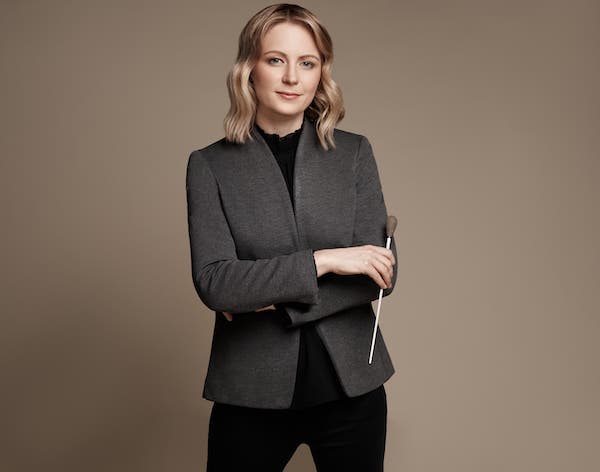Dallas Symphony and Gemma New bring dazzle and depth to Beethoven

Here in Dallas, among music critics at least, there is preoccupation with the role and responsibility of the conductor, and to whom they are chiefly beholden — the musicians under their baton, the audience, or to the score itself? These questions arise from a larger debate about who classical music is for and what is its primary function as an art form in society. Is it entertainment or an exercise in esotericism?
Thursday night’s Dallas Symphony Orchestra concert elicited ardent reactions from critics and aficionados alike responding to principal guest conductor Gemma New’s performance. Leading a program of Debussy, Bartok and Beethoven, New employed a directorial style marked by grand, gesturally fluid expression. At times, her showmanship came at the expense of rhythmic cohesion and dynamic adhesion. But the general audience consensus was intensely positive, evidenced by multiple ovations and a palpable sense of emotional fulfillment that permeated the Meyerson Symphony Center at the break and after the finale.
Opening the program was Claude Debussy’s Printemps (Spring), a symphonic suite set in two parts. Originally scored for orchestra and wordless chorus, then lost and revised by another composer without vocal parts, it was an impressionistic exploration of imagery, ensemble, and orchestral color that flouted late 19th Century conventions.
New’s treatment on Thursday yielded captivating climaxes and gripping, hushed moments. The orchestral phrasing was sweeping and descriptive, with a clarity in texture that favored distinct colorations in strings, horns, and sumptuous harp fills.
Béla Bartók’s rarely performed First Violin Concerto followed. Written for violinist Stefi Geyer, a woman Bartók loved, each movement celebrates an aspect of Geyer’s personality. Bartók’s heart is laid bare with audible shades of Strauss and Liszt as the concerto moves through a lamenting first movement to a lively second characterized by bright arpeggios and scales.
Co-concertmaster Nathan Olson gave an impassioned interpretation, thoughtfully expressive and evenly tempered. He was skillful and virtuosic in muscular passages that scurried up and down the fingerboard, and affectionately lyrical on long, legato lines. New’s orchestral textures were sometimes at odds with the soloist but the ensemble turned in a performance that was high in energy and attentive to the swaying moods plotted out by Olson.
The concert’s second half belonged to Ludwig van Beethoven’s Sixth, or “Pastoral,” Symphony, a highly pictorial work reflecting his Enlightenment-bred reverence for nature and for the provincial life of the Viennese countryside where he sometimes composed on long walks — notwithstanding his well-known distaste for a style of tonal painting that he considered the musical equivalent of landscape oils.
New’s indulgent phrasing worked well here, with the exception of more than one occurrence of clamorous fortes. Brass and horns particularly sounded too loudly. Wind solos were clean and descriptive, however, on the bird-inspired passages, and drastic dynamic shifts were, for the most part, very effective.
The thunderous brooding of the fourth movement was given notable care in the lower strings before the bright, hopeful opening of the finale. Again, New provided wide, interpretive gesturing here that yielded rushed strings, however the close was tempered, tight, and lovely. They may not have settled the what-is-classical-music debate, but for one night New and the DSO proved that classical music can be both — esoteric and entertaining.
The program repeats 7:30 p.m. Saturday and 3 p.m. Sunday at Meyerson Symphony Center. dallassymphony.org